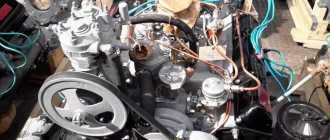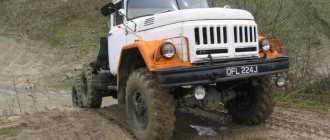Like any other part of the car, the cabin is made of metal, which, unfortunately, is susceptible to corrosion. And over time, the appearance of novelty will certainly be lost. To fix this problem you need buy a GAZ cab
new, assembled from the official dealer of Gorky Automobile.
Experience, quality, modern technology
The popularity of GAZ trucks is due not only to their excellent technical characteristics. The vehicle is easy to revive, even if its condition leaves much to be desired. New GAZ cabin
will return it to service without much difficulty.
Our company specializes in the supply of this type of product. The range includes cabins of various configurations. For each car model, you can find a suitable option in metal and a specific color. Highly qualified specialists will help you with your choice.
Modifications and release history
The car was the most popular truck of the Union republics. There were 4 million conventional, dump truck and specialized vehicles operating on the country's roads.
In 1961-1967 GAZ-53F was produced. Six-cylinder 82 liters. With. The GAZ-11 engine with a four-speed gearbox ensured the transportation of 3,500 kg of cargo, consuming 24 liters of low-octane gasoline for a run of 100 km.
By the planned release time of the model, the V-shaped eight-cylinder power unit was not in production.
For the 53F, the six-cylinder GAZ-11 was boosted, increasing the compression of the mixture. There was no ready-made hypoid rear axle, so they installed a mechanism with bevel gears from the 51A model (the car is shown in the photo).
Objectively, in terms of its technical characteristics, the GAZ-53F car was a transitional model between the 51A series (with a load of 2,500 kg) and the SAZ-53B series (with a load capacity of a ton more), which was achieved by an increased base to 3.7 m and new tires 8 ,25-20, mounted on steel disks.
The car was used not only as a dump truck, but also a sewage truck, fuel trucks and milk tankers were common.
The GAZ-53 was not a complete design; due to frequent failures of parts and mechanisms, it was not popular among drivers and repair workers of motor transport enterprises. The truck with a clearly weak engine and an unreliable axle was produced until 1967.
From 1964 to 1983, models of the 53 and 53A series with a cargo load of 3,500 and 4,000 kg hit the roads. More powerful power unit ZMZ-53 with 115 hp. With. ensured an increase in the speed parameter to 85 km/h with gasoline consumption of 25 liters per 100 km.
Find out the technical characteristics of the GAZ-66 engine in the article we prepared. And here you can find a description of the ZIL-131 KUNG.
Description of the family [edit | edit code ]
The model range of third-generation GAZ trucks included, along with the GAZ-53 with a load capacity of 3.0 (later 3.5, 4.0 and 4.5 tons), also the GAZ-52 with a load capacity of 2.5 tons and the one and a half ton GAZ-56 ( was not mass-produced) and all-wheel drive cars GAZ-62 with a load capacity of 1.2 tons and GAZ-66 with a load capacity of 2 tons. Early GAZ-53F cars produced in 1963 had a load capacity of 3.5 tons, but taking into account the results of operation it was reduced to 3.0 tons . The modernized model GAZ-53A (1965-1983) was 4-ton, and the model GAZ-53-12 (1983-1993) was 4.5-ton.
GAZ-53 and GAZ-52 cars were equipped with a unified cabin. The instrument panel of GAZ-53F vehicles did not have an ammeter and an oil pressure indicator. Instead there were warning lights. The cabins of the first GAZ-53A were equipped with a clock. There were three main types of radiator lining:
- The general idea of the design solution for the first production version of the cladding in the “look from under the brow” style was consistent with the cladding of the ZIL-130: headlights at the top, sidelights at the bottom. This type corresponded to both the GAZ-52-03 and the first GAZ-53F.
- Since 1964 - sidelights at the top, above the headlights, and a “smiling” lining.
- Since June 1984, the next, latest version of the cladding has appeared, “sad” - the grille holes have become longer, the sidelights have each moved closer to their edge.
And a year later, on all new cars, combined two-lamp, with unequal in size, orange-transparent lenses, “sidelights” (turn indicator/side marker) of a new type were installed as standard on the front. In addition, the external differences between the GAZ-53 and the GAZ-52 were in the wheel rims, so the GAZ-52 and its modifications had rims with six ventilation holes and tires measuring 220-508 (7.50-20 inches), and on the GAZ - 53, slightly larger tires were installed - 240-508 (8.25-20 inches) and wheels with three holes placed at an angle of 120°. On later GAZ-53F vehicles, wheels with two holes located at an angle of 180° were installed. The rims of GAZ-53F cars manufactured in 1963 had side and lock rings. Later, the wheels of these cars began to be equipped with one ring. On GAZ-53F cars produced in 1964, an “apron” appeared on the bumper.
Differences between the 53A line and the 53
The car models have the following differences:
- reinforced front axle;
- new cardan design;
- more reliable steering gear design;
- new radiator grille;
- turn signals are duplicated by repeaters on the wings of the cabin;
- the presence of electric windshield wipers;
- cabin heating.
In 1973, model 53A was awarded the USSR State Quality Mark. Expanding the functionality of the vehicle, the production of chassis 53 01 for covered bodies and special equipment was launched.
Chassis 53 02 was a platform for the use of a dump truck body and was equipped with a power removal device for a hydraulic pump.
Trucks of models 53 50 and 53 70 were exported. The vehicles were readily purchased in Belgium, Finland, and in socialist countries. In Bulgaria and Cuba, trucks were assembled from kits supplied from GAZ.
Model 53 12 was produced from 1983 to 1992, as a further development of the 53rd line. The truck was equipped with an eight-cylinder ZMZ-511 engine.
Power parameter is 120 hp. With. made it possible to increase the load to 4.5 tons, and the speed indicator to 90 km/h.
Gasoline consumption increased to 30 liters, but provision was made for installing equipment for refueling with liquefied or compressed gas.
Technical characteristics of the basic on-board vehicle GAZ-53:
| Index | Unit change | Meaning |
| Production period | 1964-1983 | |
| Limit dimensions (length, width, height) | mm | 6 395, 2 380, 2 220 |
| Fuel consumption | l/100 km | 24 |
| Total places | 3 | |
| Load | kg | 4 000 |
| Fully loaded weight | kg | 7 400 |
| Base between wheel axles | mm | 3 700 |
| Ground clearance is minimal | mm | 265 |
| Speed | km/h | up to 85 |
| Power unit | ZMZ-53 | |
| Clutch mechanism | one disk, dry type, with lever drive | |
| checkpoint | by four steps | |
| Rear axle main gear | single, conical, hypoid | |
| Steering column | globoid worm and three-comb roller | |
| Tire size | 8,25-20 | |
| Brake device | drum-type mechanism on all axes, with hydraulic drive |
Export [edit | edit code ]
Trucks of the GAZ-52/53 family were exported until 1993 to:
In 1967 [3] -1991, GAZ-53A and GAZ-53-12 cars were assembled from Soviet assembly kits at the Bulgarian Madara enterprise in the city of Shumen. At the same time, from the beginning of the 1970s, the cars were equipped with an 80-horsepower diesel engine produced by the Varna Engine Plant, and later with other units [4] (in particular, the production of front axles was mastered in Bulgaria) [5] (modifications: “Kolarov”, produced under license from the English company Perkins. In the 1980s, the average annual production of GAZ-53 by the Madara enterprise reached 3000 units.
GAZ 53 was produced by the Gorky Automobile Plant for more than thirty years and gained enormous popularity among the population of our country. Since the beginning of production, the model has been constantly modernized, and the last basic model is the GAZ 53 12, which has been in production since 1983.
Diesel car engine
The engine on the GAZ-53 (ZMZ-53) truck is a V-shaped, eight-cylinder (two rows of four cylinders), carburetor type, operating on a four-stroke cycle.
The working volume of the internal combustion engine cylinders of the GAZ-53 car is 4.25 liters (with a cylinder cross-sectional size of 92 mm and piston strokes of 80 mm).
Technical specifications for power 115 hp. With. The GAZ-53 engine is started using a starter.
The nominal crankshaft revolutions per minute are 3,200. The mixture compression ratio is 6.7.
Systems and mechanisms
The cylinder block is made of casting from Al-4 alloy, after casting it is sealed by heat treatment and impregnation with synthetic resin. This is a monoblock V-shaped design with an angle along the cylinder axes of 90 degrees.
The cavities of the block and cast iron liners for the pistons form the water cooling jacket of the engine. The possibility of repair replacement of sleeves is provided (5 groups with letter designations). The clutch housing is secured to the end of the block with threaded rods.
The piston group is cast from Al-30 aluminum alloy. The piston is round in shape with a flat bottom; three grooves are cut into its body for oil scraper and compression rings.
Pistons are divided into 5 repair groups according to their own diameter (letter marking) and into 4 groups according to the diameter of the piston pin hole (color marking).
The block heads are made of Al-4 alloy. Valve seats are made of cast iron, guide bushings are made of copper-graphite ceramics. The block and cylinder heads are connected by threaded rods through gaskets made of asbestos board reinforced with steel.
The crankshaft is cast from cast iron, with connecting rod journals, bearings and counterweights formed on it. The shaft undergoes dynamic and static balancing.
Axial movement of the crankshaft is eliminated by two washers installed on either side of the first journal support. It is sealed in the block with oil-sinking grooves, oil seals and asbestos packing.
The gas distribution mechanism with overhead valve installation ensures the intake of the working mixture into the cylinders and the exhaust of exhaust gas.
The device consists of: camshafts and gears, pushers, rocker arms, rods, valves, guide bushings and springs.
The camshaft is forged from steel. It has five bearing journals, cams, a gear drive for an oil pump and an ignition distributor.
The power system includes: a 90-liter gas tank, pipelines, a mechanically driven diaphragm pump, fuel filtering devices and a two-chamber K-126 carburetor - a device for preparing a fuel-air mixture.
The lubrication system supplies oil to the rubbing parts under pressure and gravity. Gear oil pump driven by a camshaft, full-flow oil filter, serviceable.
The air preparation filter is serviceable, inertial, with sedimentation of polluting particles in an oil bath.
Cooling system with water pump, closed type, liquid. It consists of a water jacket of the cylinder block, radiator, pump, thermostat, shutters, fan, fan casing, radiator cap and connecting hoses. Capacity – 22 liters. Contact ignition system.
History of creation
The GAZ 53 model is one of the most famous and popular Soviet trucks. It belongs to the 3rd generation family of medium-duty trucks. It was produced from 1959 (serial production from 1961) until the beginning of 1993 at the Gorky Automobile Plant. With its modifications it was the most popular truck in the USSR. The total number of cars produced is more than 4 million.
In October 1961, the 3.5-ton GAZ-53F, 82 hp, began production. In July 1964, the GAZ-53 itself began to be produced - a 4-ton truck with a V-shaped 8-cylinder ZMZ-53 engine, 115 hp. In 1965, the name changed to GAZ-53A.
This model was produced in various versions for many years until 1983. The GAZ-53-02 chassis was used for dump trucks, the GAZ-53-40 was used for buses, and the GAZ-53-11 chassis was used for specialized vehicles.
Since 1983, the GAZ-53-12 model was released. The radiator has a different lining, a new cylinder head has appeared, and the chassis has also undergone changes. The carrying capacity became 4.5 tons.
In 1990, the GAZ-3307 model appeared. This is where the story of the GAZ-53 ends, but quite a lot of these vehicles are still in use today.
Interior and exterior of GAZ-53
The GAZ-53 looked very modern for its time. A one-piece radiator trim was made flush with the headlights. The frame was very durable. The gas tank is located under the driver's seat. The filler neck was located at the edge of the driver's door, behind the cab.
When switching to gas fuel, this circumstance turned out to be very convenient, since the gas cylinder could be installed under the body, whereas other trucks had a gas tank there.
The starting technology was modern at that time - an electric starter with a retractor relay, there was a good heating system and electric windshield wipers.
The driver and passenger seats were made as one unit. But, nevertheless, it was comfortable to sit in the cabin even in winter in warm clothes. There are places for tools, spare parts and other necessary things.
Car export
GAZ-53 was exported to the countries of the socialist camp: Poland, East Germany, Romania, Czechoslovakia, Yugoslavia, Hungary, Vietnam, Mongolia, as well as Finland. From 1983 to 1991, the assembly of the GAZ-53-12 was carried out by the Bulgarian enterprise Madara.
Trucks of this assembly had diesel of their own production, which was produced under license from Perkins (England).
Model 53 12
The truck is designed to transport cargo weighing up to 4,500 kg on asphalt and dirt roads. The machine allowed operation at temperatures from +40 to -40º C.
Option 53 12 is a deep modernization of the 53A model with better indicators in terms of fuel economy, repair regulations and safety.
Increasing the power of the power plant and the use of new radial tires made it possible to increase the dynamics and cross-country ability of the vehicle.
Cars of the 53 27 and 53 19 series ran on compressed and liquefied gas.
The ZMZ-53-11 power unit received a sectional oil pump, a full-flow filter device, new cylinder heads with an increased compression parameter, and the crankcase ventilation was switched to a closed circuit.
The car had strengthened: spring suspension, frame elements, cross member (beam) of the axle. It was possible to reduce exhaust toxicity by 19%.
In the future, the car will be equipped with a front-view triplex, a contactless ignition system, new lighting equipment, emergency signals, and a hydraulic vacuum booster with brake pressure distribution along the axes.
Do you know the technical characteristics of the Ural-5557 dump truck, successfully used in agriculture and other areas of human activity? This review examines the basic model and varieties of the UAZ-3303.
At this address: https://spez-tech.com/tehnika/gruzovie-avto/ural/6464-osnovnyie-harakteristiki-ustroystvo.html you will find a description of the main technical characteristics of the Ural-6464 car.
What non-standard decisions can be made?
Many people choose to experiment, invent new strategies and solutions to upgrade their truck. Good auto mechanics will be able to install air suspension on a dump truck with an 8-cylinder engine. You can find trucks that are equipped with alloy wheels.
An example of a non-standard change to a familiar Soviet dump truck
In an SUV, the front axle is often replaced with a design from the GAZ-66. From this model we bought a transfer case and cardan shafts for subsequent installation. The result was a hybrid car with good performance and technical characteristics.
Standard options for improving the body are replacing the “sides” with dump equipment. You can extend the sides, install tanks, a van on a chassis, convert a truck and make a tow truck for passenger vehicles. This car will make a shift bus. You can digest the cabin, double it.
Dump truck
The truck was produced for transporting bulk cargo in the interests of agriculture and industry. Due to the hydraulic system, the unloading process was mechanized.
The capacity of the all-metal body platform is 5 cubic meters. A special mechanism allows mechanical unloading on one of the working sides.
The dump truck was produced on the GAZ-53 02 chassis with a frame shortened by 270 mm at the rear. The wheelbase remained the same. Equipped with a power take-off shaft.
The platform was equipped with a gear-type hydraulic pump, which, through a system of control valves, ensured the operation of a three-link hydraulic cylinder for lifting the body.
The rear hitch and towing devices have been moved to the sides of the frame.
Cabin GAZ 3309
Installed on cars with a diesel engine. Later, the plant began to produce unified models suitable for all fourth-generation trucks. Despite the fact that 3309 began to be produced back in the 90s of the last century, its demand has not decreased at all. The same can be said about components. After all, the GAZ cab, buy
which is available on favorable terms at the Luidor Group of Companies, is one of the main elements of the vehicle. And it is highly not recommended to neglect his condition.
Truck and camper based on the KAVZ-685 bus
Almighty KAVZ
Sergey Mikhailov, photo by the author
This happened in the 90s of the last century... when “perestroika” was born, which means the way of life was changing. It was then that I was one of the first to start doing business. But the years passed, sales volumes grew, and driving a Moskvich, even with a trailer, no longer had enough strength or time. That’s when the dream was born to find a car that would be able to carry cargo and also allow me to relax on the road. By luck, I managed to find a KAvZ-685 bus, model 1983. It turned out to be the configuration I needed, because it was a mobile registration and examination point (REP-5).
I installed 16 soft seats from the LAZ-699N Tourist-2 bus into the purchased car and, after a small modification, began using it to transport passengers. After some time, such a business stopped giving the desired profit. Some of the seats had to be removed and the bus used as a cargo-passenger bus. But when engaging in trade, it was increasingly necessary to travel for goods, and passengers became a burden. After some thought, I removed the remaining seats, returning to the option of 4 passenger seats + driver, as was the case when purchasing.
Business was growing. Using the existing technical capabilities, it was necessary to reduce fuel consumption and increase the vehicle's load-carrying capacity. This is what I did. Working for about 20 years on a GAZ-53 car (all the chassis on a bus is from a GAZ-53), I constantly thought why ZIL carries 5 tons of cargo, consuming 40 liters of gasoline, and GAZ-53 only 3.5 tons with a fuel consumption of 25 liters . Thanks to some changes, it was possible to increase the bus's load capacity to 6.5 tons, while fuel consumption remained virtually unchanged. One day we even had to transport 7.2 tons of paving slabs. It was hard, but the “old man” coped with this task. But initially the bus’s carrying capacity was only 1.5 tons.
I have only one route - from home (Ostashkov) to Moscow - 400 km there and 400 km back. There are two such day trips per week. Experienced drivers will tell you that you won’t drive like this for long. They didn’t guess right - the bus coped with this task perfectly even under heavy load. And this despite the fact that all components and assemblies are original.
I use tires only in accordance with the passport data - 240x508. I will never install any “Zilov” tires, since they do not run with such overload. I use tires only from the Nizhnekamsk tire shop, sometimes they take care of them up to 130–170 thousand km, this is in accordance with the rolling stock repair log, which is kept for the entire fleet of vehicles. This is not an exaggeration, but gratitude to rubber manufacturers.
After some time, new business difficulties arose. It was then that a new job turned up for me - transporting timber to Moscow. I started reworking again. The capacity of the cargo compartment at that time was 8 m3. I raised the roof of the bus and lengthened the base, the body became 11 m3. I installed double swing gates at the back and faced Moscow. 11 cubic meters of forest there, 6.5 tons of sand back, and so on 3 times a week. For comparison: a timber truck takes 22–25 cubic meters of timber, and I took 11!
I drove like this for almost a year. But work is work, but you need to rest somehow. I started reworking again. I installed a sleeping berth so the second driver can get a good night's sleep while driving. For eating, I set up a small table with a hole for a thermos. The sleeping place was equipped with heating. But how can we sleep here if our winters are harsh? Anyone who has worked on lawns knows how difficult it can be to heat a cabin. But in my cabin you can walk at full height, the width is at the level of a van, plus another row of seats, and it all needs to be heated.
After thinking carefully, I decided to install three stoves. I collected what I could: water, oil and just air. But even this was not enough to heat my cabin. I had to look for a new solution. After going through different heaters, I took a “stove” from an old GAZ-24 Volga car and connected it to an aluminum radiator. Air was taken from the engine compartment, heated, it passed through the heater radiator and was heated so that at –25 °C outside, the temperature in the cabin remained +25 °C. Moreover, while driving, the heater could not be turned on. The interior walls of the cabin were covered with leatherette, and synthetic padding was used as insulation. Driving such a car has become much more convenient. You could afford to open the window even in severe frosts. Now, even in severe frosts, I rode in a shirt and slippers.
But the epic of modernization did not end there.
Lawn drivers know how difficult it is to open the block tap on a car, clean it, replace the oil sensor and spark plugs. Then, in 2005, I began to think about how to rid the car of these shortcomings. I took the old trim and hood and began to reshape, cut, try on, in general, think and create. At first I wanted to leave the same look. But during the process, the original plans were abandoned.
I took the Gazelle headlights, left the original hood, just made it from fiberglass, and raised the rear part by 5-6 cm to increase streamlining. I started doing the cladding on the neighboring GAZ-53, fortunately the cars are the same. The work lasted 5 years. We had to cut, glue, and change some elements globally. The design and shape of the “face” was born in my head as the work progressed. The main idea was to simplify everything to the minimum. I did everything according to patterns, which I made from iron (using cold riveting), as well as from plywood and cardboard. Then he applied fiberglass and molded the parts. Often everything had to be cut and remade again.
I decided to keep my wings, but the front part was covered with headlights. I also placed the engine compartment fenders against the wing, and made the whole thing foldable. I wanted to combine the cladding of the GAZ-53 and GAZ-51 cars. In my opinion, I succeeded. The result is a very convenient design. Now any repair is a pleasure. The front bumper was left original, only fog lights were embedded into it and decorated with a wide plastic additional bumper 300 mm wide.
The radiator trim is simplified to the maximum - a chrome grille. All headlights can turn on simultaneously, allowing for good visibility at night. The number of light bulbs on the illumination is 22. For safe driving on icy roads, I use tires studded in 4 lanes. To increase the mileage I installed an additional 70 liter gas tank. For convenience, the gas tank switching valve was brought into the cabin. Now the car can travel up to 700 km without refueling.
During operation, I tried the bus in different speed modes. Thanks to the streamlined body and driving skills, fuel consumption increased to 16 liters per 100 km. On a flat road I accelerated to 120 km/h. Currently the engine runs on APAL oil. The battery was set to 62 Ah, not 75 Ah. Works. Why install a large one if a 62-amp one starts the engine normally?
Now I have moved away from “big business” and engaged in creative activities. I re-equipped the bus again and use it as a camper for fishing, hunting trips or just for outdoor recreation, fortunately the volume allows it. When going on vacation, you can take an all-terrain vehicle with you, or a snowmobile in winter. The bus can also be used as part of a road train. I opened the windows, set up the sofa, the power station is always with me. There is not enough furniture, but what do you need for relaxation? The main thing is to have somewhere to sleep, relax, eat, and you can hit the road again. Thanks to the large carrying capacity, you can take a significant supply of water, which is necessary on the road both for cooking and for taking a shower. A fairly high seating position contributes to high cross-country ability.
In the summer of 2010, friends invited me to visit the exhibition “Autoexotica-2010”, look at the gifted guys and show off (“GP” No. 9, 2010). How many of us are in our garages inventing new products that are of no interest to anyone but us? But it would be possible to make such a model from the GAZ-3307.
I can disassemble my car in 20 minutes: the integral hood is separate, the fenders are separate, the bumper is separate, and the car remains in working order. For comparison, remove at least the radiator trim from the GAZ-3307. How long will it take you to remove the wing? I can remove the wing on my bus in 5 minutes. I can stand at full height on the integral plastic hood and it won’t even bend. And all this can be lifted with one hand, and, moreover, it does not rust and, more importantly, does not rot. In the future I want to assemble an 8-speed gearbox.
As you can see, one machine can be used for many jobs. Experienced drivers do not believe the carrying capacity of my bus. Only those who traveled directly with me or communicated closely with me believe. There were even cases when traffic police officers slowed down to watch how this “old man” overtook foreign cars coming in the same direction.
As of today, my car's mileage is 1,000,000 km, and that's a lot. This means that our cars can be used for a long time even with such a load. When I go out onto the highway, drivers of oncoming cars look at me, passers-by look at me, which means that our people are not indifferent to beautiful things. And beautiful is when the old is combined with the new and the car is kept in perfect order.
Since childhood, I have not been used to driving domestic factory-produced cars. Every car I've owned in 25 years has had its own modifications. So, on the Moskvich-412, instead of a rocker, the lever was inserted directly into the gearbox. Even the factory didn’t think of this until the last day. I switched the car from 13-inch tires to 14-inch ones, which saves fuel. And all this happened in the 1990s.
Over the years, I have accumulated enormous experience, which may be useful to someone. I would like the designers who come up with domestic “cars” to appeal more to those who drive their designs every day. We would tell you what the driver needs for normal work. Even those cars that are already driving on the roads can be raised a step higher without investing large sums of money. But only the DRIVER can tell you how to do this, who repairs their creations with his own hands in 30-degree frost on the side of the road!
www.gruzovikpress.ru
About the history of the legendary truck and its features
Unlike all previously developed trucks of the Country of Soviets, the GAZ-53 was originally created purely for the needs of the national economy. In case of war, it was not planned to mobilize it into troops and use it to transport guns, transport ammunition, wounded, etc. army needs. In this regard, the GAZ-53 can rightfully be called the first domestic “NOT dual-use” truck.
This explains the “cheerful” colors of the legendary car. If previously all trucks of the Soviet Union were painted only in a dark green protective color, then the 53rd from the very beginning was distinguished by a very diverse range of colors: its cabs were painted in blue, gray, blue, beige, red, green, yellow, orange and some others colors.
The direct “relative” and “ancestor” of the GAZ-53 was another all-Union hard worker - the GAZ-51 truck. The development of a new generation truck was led by the chief designer of the Gorky Automobile Plant, Alexander Dmitrievich Prosvirnin (1914-2005). By the way, he was in 1946-1947. participated in the development of the GAZ-51, then still in the role of an ordinary designer.
During the summer/autumn of 1961, a pilot batch of GAZ-53F trucks was subjected to serious tests, the main of which was a motor rally along the route Moscow - Tashkent - Moscow, with a total length of ten thousand kilometers. The trucks were driven intensively along country roads and real deserts, steppe sands, marshy soils and mountainous areas. The culmination of the route in Central Asia was the Shahristan pass, in Tajikistan, located at an altitude of more than 3.2 thousand meters above sea level.
At the same time, 2 GAZ-53Fs were mercilessly exploited in the Moscow region, in off-road rural conditions, and 4 more were driven along the Moscow-Gorky highway back and forth until the figure of 15,000 km was reached on their speedometer, testing reliability on main lines. In total, each of the vehicles performed 18 flights.
By the way, the “sibling” of the 53rd GAZon, the GAZ-52, also deserves kind words. Also a bestseller, with a circulation of more than 1 million units. This is practically its “twin”. Since the only reliable difference between these models is the model of the installed engine: on the 52nd there is a six-cylinder in-line, on the 53rd there is a more powerful eight-cylinder V-shaped.
By the way, according to the observations of experienced GAZON drivers, the 52nd was distinguished by slightly better cross-country ability in severe off-road conditions or deep snow. The more powerful and resourceful GAZ-53 was more likely to bury itself in mud, snow or sand where the 52nd was slowly passing on its own.
Externally, it was possible to distinguish the GAZ-52 from the GAZ-53 by the wheel rims: the GAZ-52 and modifications had smaller rims, with 6 ventilation holes and narrower tires. The GAZ-53 has wider (and, accordingly, more “load-bearing”) tires; wheels of a larger diameter, with three holes placed at an angle of 120 degrees. However, the rims on the 52nd and 53rd GAZon are interchangeable.











